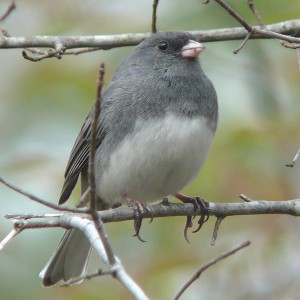Animals generally live in multisensory worlds, relying upon many different types of information to ensure survival. For animals living in groups who use social information to make decisions, two types of information may be available from other group members: cues and signals. Cues are behaviors inadvertently left by an individual, such as seeing a friend running over to the stove while something is cooking, while signals are behaviors produced by an individual and directed toward others, such as your friend yelling to you that she needs help because the stove is on fire. While both pieces of information are informative, it is hard to say whether they elicit the same response in an individual. Is it possible that having both pieces of information, compared to just one, is advantageous?

Dark-eyed Junco
Randolet et al. (2014) studied the antipredator behavior of the dark-eyed junco, a small American sparrow, which uses alarm calls as an auditory signal and flushing, or fleeing, as a visual cue to warn flock mates of an approaching predator. The researchers predicted that alarm calling and flushing were redundant stimuli, and would therefore elicit the same behavioral response in the juncos. To test this, robotic birds were created to set up an artificial flock, and number of group mates, alarm calling, and/or flushing behavior was manipulated in the robotic birds to resemble varying degrees of risk. Live birds were exposed to these artificial flocks, and their responses to the different levels of risk of the different stimuli were recorded. Change in head position, stretched neck, crouching, movement, flushing, and body turn were all recorded, as these are typical antipredator behaviors of the juncos.
The results of the study were contrary to initial predictions, as they showed that multisensory stimuli affect different components of the junco antipredator behavior. In fact, none of the antipredator behaviors performed by the juncos were affected simultaneously by both the alarm calls and flushing behavior, suggesting that these stimuli are non-redundant. Additionally, the degree of alarm of the live birds increased when at least one robot flushed, but reaction times to the robots’ behavior increased, rather than decreased, with at least one alarm call. This suggests possible costs to using each behavior individually, and suggests that, together, these stimuli could facilitate flock cohesion and reduce the occurrence of false alarms to predators.
Although alarm calls and flushing behavior were predicted to be redundant stimuli, it is apparent that there are costs to using each stimulus individually. A flock mate flushing may reflect individuals seeking foraging opportunities, rather than fleeing a predator attack. Thus, if the juncos were to flee the patch each time they witnessed a flock mate flushing, the behavior could waste energy and may result in a loss of foraging opportunities. Additionally, according to the results of the study, alarm calling could actually reduce the benefits of living in a group, by delaying responses to predator attacks. However, it may have been difficult for the researchers in this study to distinguish between alarm calls and low-risk warning calls, which could have caused the results seen.
Randolet et al. (2014) have demonstrated that juncos likely use a non-redundant multisensory system to minimize the occurrence of false alarms using stimuli in different sensory modalities to determine the type of threat. This may ultimately facilitate group cohesion among flocks, allowing for more successful foraging and antipredator behaviors.
Randolet, J., Lucas, J. R., & Fernández‐Juricic, E. (2014). Non‐Redundant Social Information Use in Avian Flocks with Multisensory Stimuli. Ethology

